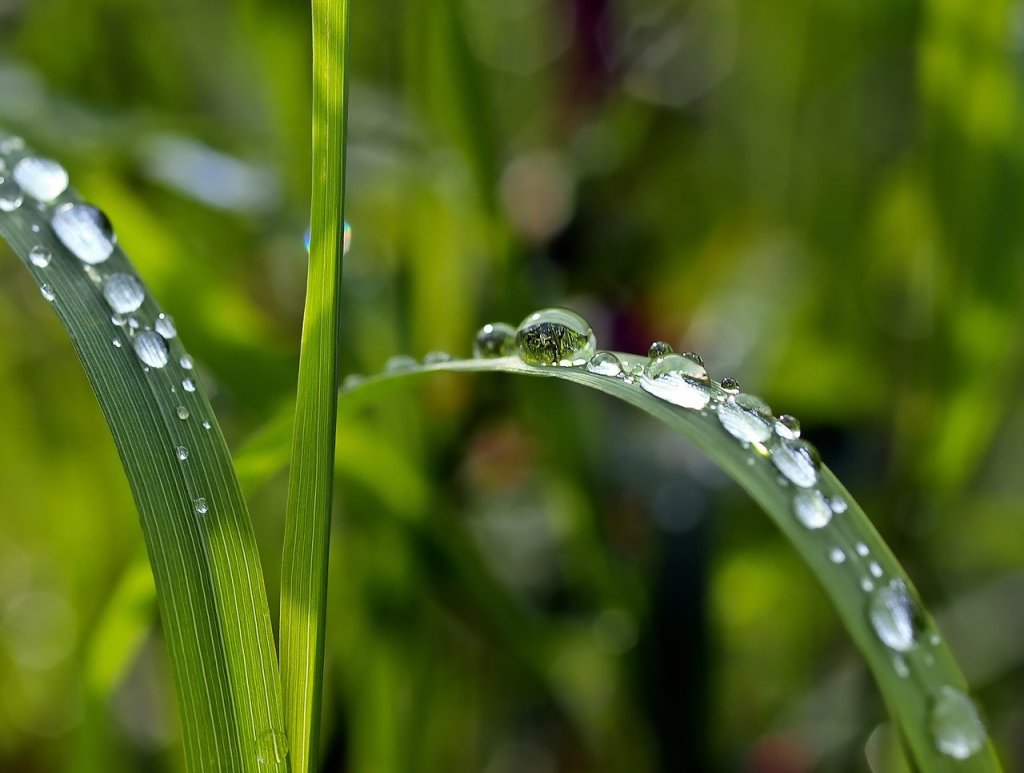
I can’t help it, I find images of water drops fascinating. The way the tiny globes reflect and refract light like jewels, and the contrast they offer to the colorful surfaces they cling to. After clicking through dozens of drops, I realized I didn’t remember much about the how or why of what I was admiring. I thought I’d brush up on the science of water drops with the help of some free and beautiful photos I downloaded.
The properties of cohesion and surface tension account for much of a drop’s shape. Liquid molecules cohere to one another, and no liquid is more cohesive than water. Water molecules like their neighbors so much they grip each other as tightly as possible. As they draw inward, they create the smallest possible shape–a sphere. In a place where no opposing forces like gravity and air resistance disfigure them, like deep space, the sphere is perfect.

Drops keep their shape because of surface tension, which creates a toughened outer edge. Water molecules below the surface of a drop pull at their neighbors all around them. But those at the edge have no one beyond themselves to pull, so they pull at those in the other directions. This creates a lateral tension across the surface. See the illustration at right.
The same process occurs at the surface of a pond. Because of surface tension, a steel paper clip can float, despite steel’s higher density than water, and insects like Water Striders can walk across puddles. In the following photos, note how these floaters press down into the water without breaking through. That’s surface tension in action, fighting back against the intruders.



While water’s surface tension is tops among non-metallic liquids (mercury’s is stronger), it’s no match for soap. And that’s a very good thing, because soap works within water to kill germs like the coronavirus. Soap bonds with water by first breaking through water’s surface tension. Once inside, soap molecules form tiny bubbles called micelles. As you rub your soapy hands together, the micelles surround the individual viruses and tear through their protective membranes. What’s left, including dirt, gets trapped in the micelles and washed down the drain. Soap is brutally effective on germs, even more than hand sanitizers.
But cohesion and surface tension are only part of the story of water drops. While water molecules cling to each other, they adhere to many other molecules, too. As you can see in the photos below, water sticks to the silk strands of a spider’s web like pearls on a necklace…

…and to the thin bristles of puffy, white dandelion “parachutes”…

…and to the smooth, waxy surface of blades of grass.

Water adheres to other surfaces because it’s attracted to those materials at the molecular level. We can tell how much water prefers a surface by noting the presence and shape of drops. It favors the fibrous silk of a spider’s web and especially where strands twist together in knots. Water prefers the puffy tops of dandelion parachutes more than the stems. The waxy surface of the grass is less attractive overall, which is why we see the drops pull themselves into tight beads; but the grass is not so repellent that the drops roll off. We see the same phenomenon on the surface of waxed cars after a good rain. Adhesion always interacts with cohesion and surface tension to influence the size and shape of water drops: Too much adhesion and the drop stretches or flattens into a puddle; too little and the drop pulls into a sphere and detaches.


The extreme adhesion of water leads to a phenomenon called meniscus. Water molecules love smooth glass. Notice how they grip the inside surface of the eyedropper at left? They pull and push each other up the side of the dropper. Only gravity limits how high the water molecules climb.
Gravity plays a part in the formation and shape of water drops, too. As a drop’s size grows, gravity pulls and stretches it toward the ground. Eventually, the drop’s surface tension fails and some of its molecules break free. As the new drop falls, surface tension regains control and pulls the molecules back into a near-sphere.



I leave you with this final picture. If all the world’s water accumulated in just a few drops, they’d look like this.

Works Cited
“Adhesion.” Wikipedia.
“Adhesion and Cohesion of Water.” United States Geological Survey (USGS).
“Bursting with Excitement–A Look at Bubbles and Fluids in Space.” NASA.
“Drop (Liquid).” Wikipedia.
Fang, Janet. “Why Spider Webs Glisten with Dew.” Nature. 3 Feb 2010.
Goodman, Jeff. “Water Drops: Cohesion and Adhesion.” Appalachian State University.
“How Washing Hands with Soap Destroys the Coronavirus.” Global Handwashing Partnership. 8 Apr 2020.
“Hydrophobic Effect.” Wikipedia.
“Revealed: the Extraordinary Flight of the Dandelion.” Nature. 17 Oct 2018.
“Surface Tension.” Wikipedia.
“Surface Tension and Water.” USGS.
“Water is Space: How Does Water Behave in Outer Space?” USGS.
“Water Meniscus.” USGS.
Categories: things
Incredible, I just love taking photos of water droplets. Often it is hard to capture without blur because of the complexity of the water against the leaf.
LikeLike
Well, I appreciate the effort you take to get the perfect shot!
LikeLike
What a brilliant blog! I will read all. Thank you for the photos. You are great!
Joanna
LikeLike
Thanks! I appreciate that.
LikeLike
I love re-reading your posts and the photos are beyond beautiful and interesting. Thank you.
Thank you for liking my posts.
Joanna
LikeLike
I consider your posts a gold standard for scholarship and readability, Joanna, so your praise is much appreciated.
LikeLike